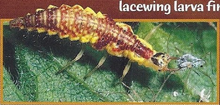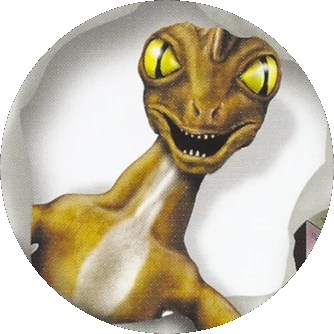Like many insects, green lacewings lead very different lives as adults than they do as larvae. Adults mostly fly around in search of a mate while trying to avoid predators. Larvae, however, are viscous predators themselves. These creatures use huge jaws and sharp mouthparts to devour masses of insect prey.
Killer Kid: Most adult green lacewings feed on plant juices (though some eat insects), but the larvae are completely carnivorous. Young lacewings have long, curved jaws that hold prey while they are devoured.
Liquid Lunch: While holding a victim in place, a lacewing larva pierces its prey's body with sharp mouthparts just below the jaws. These hollow weapons inject digestive juices into prey, then suck out the liquefied remains.
Aphids: Curiously Delicious[]

A steady diet of aphids helps the larva double in size as they mature.
Green lacewing larvae have a definite favorite food: tiny, leaf-munching insects called aphids. The predators will climb over hundreds of feet of leaves in search of aphid colonies, which can consist of 50 or more of the delicate prey. Once a lacewing larva finds such a bounty, it picks them up one at a time until it devours every last one. A typical young lacewing can eat up to 200 aphids in a week.
First Flight: Adult lacewings emerge from their cocoons with two sets of wide, clear wings, and are ready to fly. Greenish veins run through the wings and gave the insects their name.
Bat Signal: One of an adult green lacewing's biggest enemies are bats. Some lacewing species, however, have sensors in their wings that detect a bat's high-pitched squeals, allowing them to escape.
Corpse Cover[]
- A hungry green lacewing larva finds a colony of aphids and begins to chow down. It grabs one in its jaws and sucks out its juicy insides.
- Having sucked its victim dry, the lacewing larva swings its head back and sticks the empty husk onto tiny hairs on its back to help camouflage it from enemies.
- Having finished with one aphid, the young predator turns its attention to another live one from the colony, grabs it in its jaws and starts the process again.
Trivia[]
- The "Prey" section says "soft-bodies insects" instead of "soft-bodied insects".
